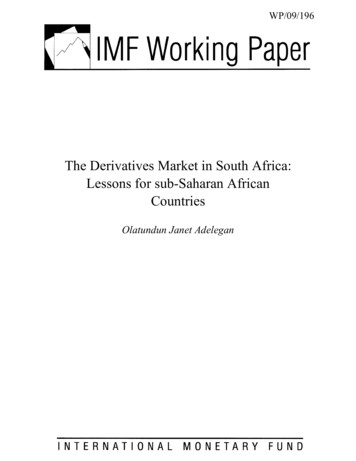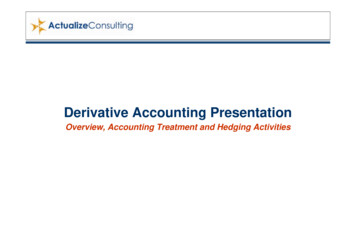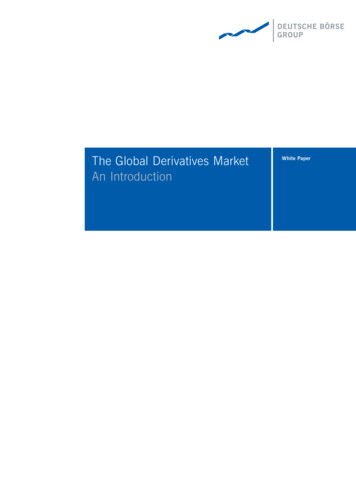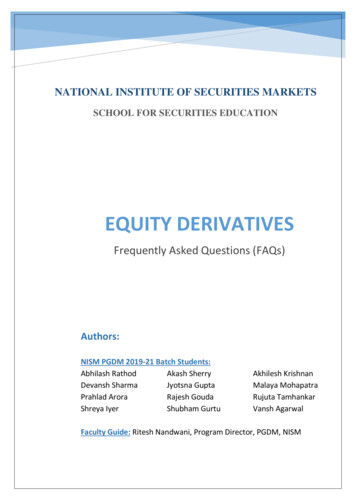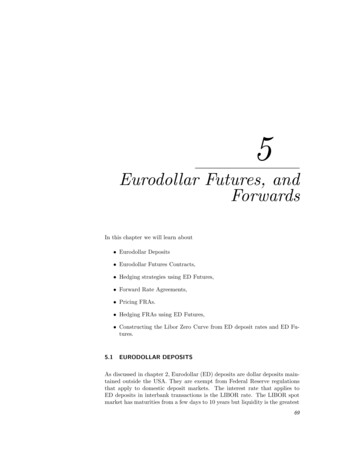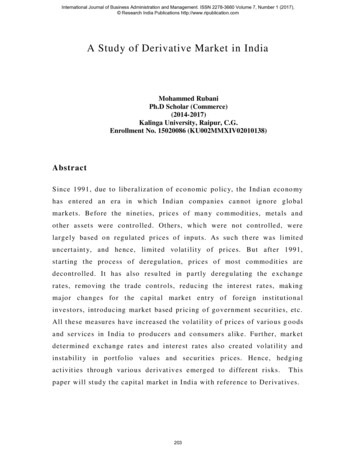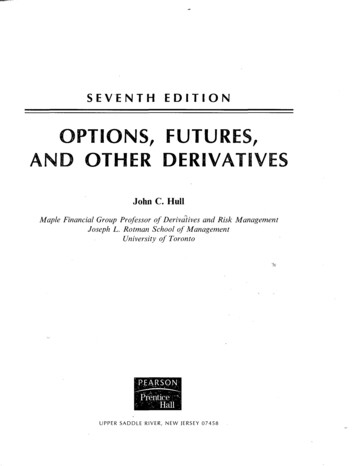
Transcription
SEVENTHEDITIONOPTIONS, FUTURES,AND OTHER DERIVATIVESJohn C. HullMaple Financial Group Professor of Derivatives and Risk ManagementJoseph L. Rotman School of ManagementUniversity of TorontoPrentice: C HailUPPER SADDLE RIVER, NEW JERSEY 07458
ContentsList of Business SnapshotsxviiList of Technical NotesxviiiPrefaceChapter 1. Introduction1.1Exchange-traded markets1.2Over-the-counter markets1.3Forward contracts1.4Futures contracts1.5Options1.6Types of traders1.7Hedgers1.8Speculators1.9Arbitrageurs1.10 DangersSummaryFurther readingQuestions and problemsAssignment questionsxix,-Chapter 2. Mechanics of futures markets2.1Background2.2Specification of a futures contract2.3Convergence of futures price to spot price2.4Daily settlement and margins2.5Newspaper quotes2.6Delivery2.7Types of traders and types of orders2.8Regulation2.9Accounting and tax2.10 Forward vs. futures contractsSummaryFurther readingQuestions and problemsAssignment questionsChapter 3. Hedging strategies using futures3.1Basic principles3.2Arguments for and against hedging3.3Basis risk,3.4Cross 5363739404141434545485154vii
Contentsvm3.53.6Stock index futuresRolling the hedge forwardSummary;Further readingQuestions and problemsAssignment questionsAppendix: Proof of the minimum variance hedge ratio formulaChapter 4. Interest rates4.1Types of rates4.2Measuring interest rates4.3Zero rates4.4Bond pricing4.5Determining Treasury zero rates4.6Forward rates4.7Forward rate agreements4.8Duration4.9Convexity4.10 Theories of the term structure of interest ratesSummaryFurther readingQuestions and problemsAssignment questionsChapter 5. Determination of forward and futures prices.5.1Investment assets vs. consumption assets5.2Short selling5.3Assumptions and notation5.4Forward price for an investment asset5.5Known income5.6Known yield5.7Valuing forward contracts'. :.5.8Are forward prices and futures prices equal?5.9Futures prices of stock indices5.10 Forward and futures contracts on currencies5.11 Futures on commodities5.12 The cost of carry5.13 Delivery options5.14 Futures prices and the expected future spot priceSummaryFurther readingQuestions and problemsAssignment questionsAppendix: Proof that forward and futures prices are equal when interestrates are constantChapter 6. Interest rate futures6.1Day count and quotation conventions6.2Treasury bond futures6.3Eurodollar futures6.4Duration-based hedging strategies using futures6.5Hedging portfolios of assets and liabilitiesSummaryFurther 22125126129129132136141142143144
ContentsixQuestions and problemsAssignment questionsChapter 7. Swaps7.1Mechanics of interest rate swaps7.2Day count issues7.3Confirmations7.4The comparative-advantage argument7.5The nature of swap rates7.6Determining the LIBOR/swap zero rates7.7Valuation of interest rate swaps7.8Currency swaps7.9Valuation of currency swaps7.10 Credit risk7.11 Other types of swapsSummaryFurther readingQuestions and problemsAssignment questionsChapter 8. Mechanics of options markets8.1Types of options8.2Option positions8.3Underlying assets8.4Specification of stock options8.5Trading?.8.6Commissions8.7Margins8.8The options clearing corporation8.9Regulation8.10 Taxation8.11 Warrants, employee stock options, and convertibles8.12 Over-the-counter marketsSummaryFurther readingQuestions and problemsAssignment questionsChapter 9. Properties of stock options9.1Factors affecting option prices9.2 "' Assumptions and notation9.3Upper and lower bounds for option prices9.4Put-call parity9.5Early exercise: calls on a non-dividend-paying stock9.6Early exercise: puts on a non-dividend-paying stock9.7Effect of dividendsSummaryFurther readingQuestions arid problemsAssignment questionsChapter 10. Trading strategies involving options10.1 Strategies involving a single option and a stock10.2 Spreads10.3 6218219219221230
xContents10.4Other payoffsSummaryFurther readingQuestions and problemsAssignment questionsChapter 11. Binomial trees11.1 A one-step binomial model and a no-arbitrage argument11.2 Risk-neutral valuation11.3 Two-step binomial trees11.4 A put example.-.11.5 American options11.6 Delta11.7 Matching volatility with u and d11.8 Increasing the number of steps11.9 Options on other assetsSummaryFurther readingQuestions and problemsAssignment questionsChapter 12. Wiener processes and Ito's lemma12.1 The Markov property12.2 Continuous-time stochastic processes12.3 The process for a stock price12.4 The parameters12.5 Ito's lemma12.6 The lognormal propertySummary. Further readingQuestions and problemsAssignment questionsAppendix: Derivation of Ito's lemmaChapter 13. The Black-Scholes-Merton model13.1 Lognormal property of stock prices13.2 The distribution of the rate of return13.3 The expected return13.4 Volatility.13.5 The idea underlying the Black-Scholes-Merton differential equation13.6 Derivation of the Black-Scholes-Merton differential equation13.7 Risk-neutral valuation13.8 Black-Scholes pricing formulas13.9 Cumulative normal distribution function13.10 Warrants arid employee stock options13.11 Implied volatilities13.12 DividendsSummaryFurther readingQuestions and problemsAssignment questionsAppendix: Proof of the Black-Scholes-Merton 52256256257258259259260265268269270271272:-.-. 1302303305307
ContentsxiChapter 14. Employee stock options14.1 Contractual arrangements14.2 Do options align the interests of shareholders and managers?14.3 Accounting issues14.4 Valuation14.5 Backdating scandalsSummaryFurther readingQuestions and problemsAssignment questionsChapter 15. Options on stock indices and currencies15.1 Options on stock indices15.2 Currency options15.3 Options on stocks paying known dividend yields15.4 Valuation of European stock index options15.5 Valuation of European currency options15.6 American optionsSummaryFurther readingQuestions and problemsAssignment questionsChapter 16. Futures options16.1 Nature of futures options.16.2 Reasons for the popularity of futures options16.3 European spot and futures options16.4 Put-call parity16.5 Bounds for futures options16.6 Valuation of futures options using binomial trees16.7 Drift of a futures prices in a risk neutral world16.8 Black's model for valuing futures options16.9 American futures options vs. American spot options16.10 Futures-style optionsSummaryFurther readingQuestions and problemsAssignment 0332335336337337338340341341344344345346347349it;. 350352352353354354356Chapter 17. The Greek 7.1117.1217.1317.14IllustrationNaked and covered positionsA stop-loss strategyDelta hedgingThetaGammaRelationship between delta, theta, and gammaVegaRhoThe realities of hedgingScenario analysisExtension of formulasPortfolio insuranceStock market 380382
xiiContentsSummary383Further reading384Questions and problems384Assignment questions386Appendix: Taylor series expansions and hedge parameters388Chapter 18. Volatility smiles38918.1 Why the volatility smile is the same for calls and puts38918.2 Foreign currency options39018.3 Equity options39318.4 Alternative ways of characterizing the volatility smile39518.5 The volatility term structure and volatility surfaces39618.6 Greek letters39718.7 When a single large jump is anticipated398Summary400Further reading400Questions and problems401Assignment questions402Appendix: Determining implied risk-neutral distributions from volatilitysmiles,404Chapter 19. Basic numerical procedures40719.1 Binomial trees.40719.2 Using the binomial tree for options on indices, currencies, and futurescontracts41419.3 Binomial model for a dividend-paying stock41719.4 Alternative procedures for constructing trees42219.5 Time-dependent parameters42519.6 Monte Carlo simulation42619.7 Variance reduction procedures43319.8 Finite difference methods435Summary.;. 446Further reading446Questions and problems447Assignment questions.449Chapter 20. Value at risk45120.1 The VaR measure45120.2 Historical simulation45420.3 Model-building approach45620.4 Linear model!45820.5 Quadratic model46220.6 Monte Carlo simulation46420.7 Comparison of approaches46520.8 Stress testing and back testing46620.9 Principal components analysis466Summary470Further reading470Questions and problems471Assignment questions472Appendix: Cash-flow mapping474Chapter 21. Estimating volatilities and correlations47721.1 Estimating volatility47721.2 The exponentially weighted moving average model: 479
Contentsxiii21.321.421.521.621.7The GARCH (1,1) modelChoosing between the modelsMaximum likelihood methodsUsing GARCH (1,1) to forecast future volatilityCorrelationsSummaryFurther readingQuestions and problemsAssignment questionsChapter 22. Credit risk22.1 Credit ratings22.2 Historical default probabilities22.3 Recovery rates22.4 Estimating default probabilities from bond prices22.5 Comparison of default probability estimates22.6 Using equity prices to estimate default probabilities22.7 Credit risk in derivatives transactions22.8 Credit risk mitigation22.9 Default correlation22.10 Credit VaR.'SummaryFurther readingQuestions and problemsAssignment questions ?.Chapter 23. Credit derivatives23.1 Credit default swaps23.2 Valuation of credit default swaps23.3 Credit indices23.4 CDS forwards and options23.5 Basket credit default swaps23.6 Total return swaps23.7 Asset-backed securities23.8 Collateralized debt obligations23.9 Role of correlation in a basket CDS and CDO23.10 Valuation of a synthetic CDO23.11 Alternatives to the standard market modelSummaryFurther readingQuestions and problemsAssignment questionsChapter 24. Exotic options24.1 Packages24.2 Nonstandard American options24.3 Forward start options24.4 Compound options24.5 Chooser options24.6 Barrier options24.7 Binary options24.8 Lookback options24.9 Shout options24.10 Asian options; 61563564
xivContents24.1124.1224.1324.14Options to exchange one asset for anotherOptions involving several assetsVolatility and variance swapsStatic options replicationSummaryFurther readingQuestions and problemsAssignment questionsAppendix: Calculation of moments for valuation of basket options andAsian optionsChapter 25. Weather, energy, and insurance derivatives25.1 Review of pricing issues25.2 Weather derivatives25.3 Energy derivatives25.4 Insurance derivativesSummaryFurther readingQuestions and problemsAssignment questionChapter 26. More26.126.226.326.426.426.526.626.7Chapter 28. Interest rate derivatives: the standard market models28.1 Bond options28.2 Interest rate caps andfloors578581581582583586587588588589on models and numerical proceduresAlternatives to Black-ScholesStochastic volatility modelsThe IVF model,,Convertible bondsPath-dependent derivativesBarrier optionsOptions on two correlated assetsMonte Carlo simulation and American optionsSummaryFurther readingQuestions and problemsAssignment questionsChapter 27. Martingales and measures27.1 The market price of risk27.2 Several state variables27.3 Martingales27.4 Alternative choices for the numeraire27.5 Extension to several factors27.6 Black's model revisited27.7 Option to exchange one asset for another27.8 Change of numeraire27.9 Generalization of traditional valuation methodsSummaryFurther readingQuestions and problemsAssignment questionsAppendix: Handling multiple sources of 602606609611616ir. 617618620 7652
Contentsxv28.328.428.5European swap optionsGeneralizationsHedging interest rate derivativesSummaryFurther readingQuestions and problemsAssignment questions658662662663664664665Chapter 29. Convexity, timing, and quanto adjustments29.1 Convexity adjustments29.2 Timing adjustments29.3 QuantosSummaryFurther readingQuestions and problemsAssignment questionsAppendix: Proof of the convexity adjustment formula667667671673676676677678680Chapter 30. Interest rate derivatives: models of the short rate30.1 Background30.2 Equilibrium models30.3 No-arbitrage models30.4 Options on bonds30.5 Volatility structures30.6 Interest rate trees,.30.7 A general tree-building procedure30.8 Calibration30.9 Hedging using a one-factor modelSummaryFurther readingQuestions and problemsAssignment questionsChapter 31. Interest rate derivatives: HJM and LMM31.1 The Heath, Jarrow, and Morton model31.2 The LIBOR market model31.3 Agency mortgage-backed securitiesSummaryFurther readingQuestions and problemsAssignment questionsChapter 32. ns on the vanilla dealCompounding swapsCurrency swapsMore complex swapsEquity swapsSwaps with embedded optionsOther swapsSummaryFurther readingQuestions and problemsAssignment L. 740741742742742
xviChapter 33. Real options33.1 Capital investment appraisal33.2 Extension of the risk-neutral valuation framework33.3 Estimating the market price of risk33.4 Application to the valuation of a business33.5 Commodity prices33.6 Evaluating options in an investment opportunitySummaryFurther readingQuestions and problemsAssignment questionsChapter 34. Derivatives mishaps and what we can learn from them34.1 Lessons for all users of derivatives34.2 Lessons for financial institutions34.3 Lessons for nonfinancial corporationsSummaryFurther readingGlossary of 761765770771771773DerivaGem software793Major exchanges trading futures and options799Table for N(x) when x 0800Table for N(x) when x 0801Author index803Subject index807
OPTIONS, FUTURES, AND OTHER DERIVATIVES John C. Hull Maple Financial Group Professor of Derivatives and Risk Management . Trading strategies involving options 219 10.1 Strategies involving a single option and a stock 219 10.2 Spreads 221 10.3 Combinations 230. x Contents 10.4 Other payoffs 233
